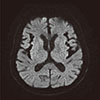Abstract
Cefepime is an extended-spectrum, fourth-generation cephalosporin that has been widely used for approved indications such as febrile neutropenia. Common adverse events of cefepime include headache, skin rash, gastrointestinal problems, and fever. However, encephalopathathy caused by cefepime has been sporadically reported worldwide over the last decade. We experienced a rare case of cefepime-induced encephalopathy. A 75-year-old man with a 30-year history of chronic obstructive pulmonary disease was admitted to the medical intensive care unit under a diagnosis of pneumonia. Initial antibiotic therapy was started with piperacillin/sulbactam and ciprofloxacin. His condition was improved with this treatment. About 2 months later, his condition was aggravated again, with mild fever and purulent sputum. Intravenous cefepime was selected on the basis of antibiotic susceptibility to Pseudomonas aeruginosa isolated from his sputum. However, his mentality became drowsy 48 hours after cefepime adminstration. He showed tremors and right facial paralysis. Neurologic examination for motor power and sensory function revealed normal findings. Laboratory tests, including serum electrolytes, glucose, osmolality, and ammonia, gave normal results. Brain magnetic resonance imaging showed chronic ischemic and atropic changes, and an electroencephalography revealed triphasic waves. The administration of cefepime was stopped, and his symptoms started to improve within 48 hours. Electroencephalography results became normalized, and he completely recovered within 48 hours after discontinuation of cefepime.
Figures and Tables
References
1. Yahav D, Paul M, Fraser A, Sarid N, Leibovici L. Efficacy and safety of cefepime: a systematic review and meta-analysis. Lancet Infect Dis. 2007; 7:338–348.

3. Jallon P, Fankhauser L, Du Pasquier R, Coeytaux A, Picard F, Hefft S, et al. Severe but reversible encephalopathy associated with cefepime. Neurophysiol Clin. 2000; 30:383–386.

4. Ryu JA, Lee SM, Kim JI, Lee GH, Lee CM, Song YM, et al. Cefepime-induced reversible encephalopathy with triphasic waves in patients with impaired renal function. J Korean Epilepsy Soc. 2009; 13:15–18.
5. Baek SD, Park SJ, Baek CH, Koo TY, Kang JK, Kim SB. Neurotoxicity induced by cefepime in a patient with minimal change disease. Korean J Nephrol. 2010; 29:796–801.
6. Gilbert DN, Moellering RC, Eliopoulos GM, Chambers HF, Saag MS, editors. The Sanford guide to antimicrobial therapy. 43th ed. Sperryville, VA: Antimicrobial Therapy;2013.
7. Sonck J, Laureys G, Verbeelen D. The neurotoxicity and safety of treatment with cefepime in patients with renal failure. Nephrol Dial Transplant. 2008; 23:966–970.

8. Chow KM, Szeto CC, Hui AC, Wong TY, Li PK. Retrospective review of neurotoxicity induced by cefepime and ceftazidime. Pharmacotherapy. 2003; 23:369–373.

9. Barbhaiya RH, Knupp CA, Forgue ST, Matzke GR, Guay DR, Pittman KA. Pharmacokinetics of cefepime in subjects with renal insufficiency. Clin Pharmacol Ther. 1990; 48:268–276.

10. Lamoth F, Buclin T, Pascual A, Vora S, Bolay S, Decosterd LA, et al. High cefepime plasma concentrations and neurological toxicity in febrile neutropenic patients with mild impairment of renal function. Antimicrob Agents Chemother. 2010; 54:4360–4367.





 PDF
PDF ePub
ePub Citation
Citation Print
Print





 XML Download
XML Download